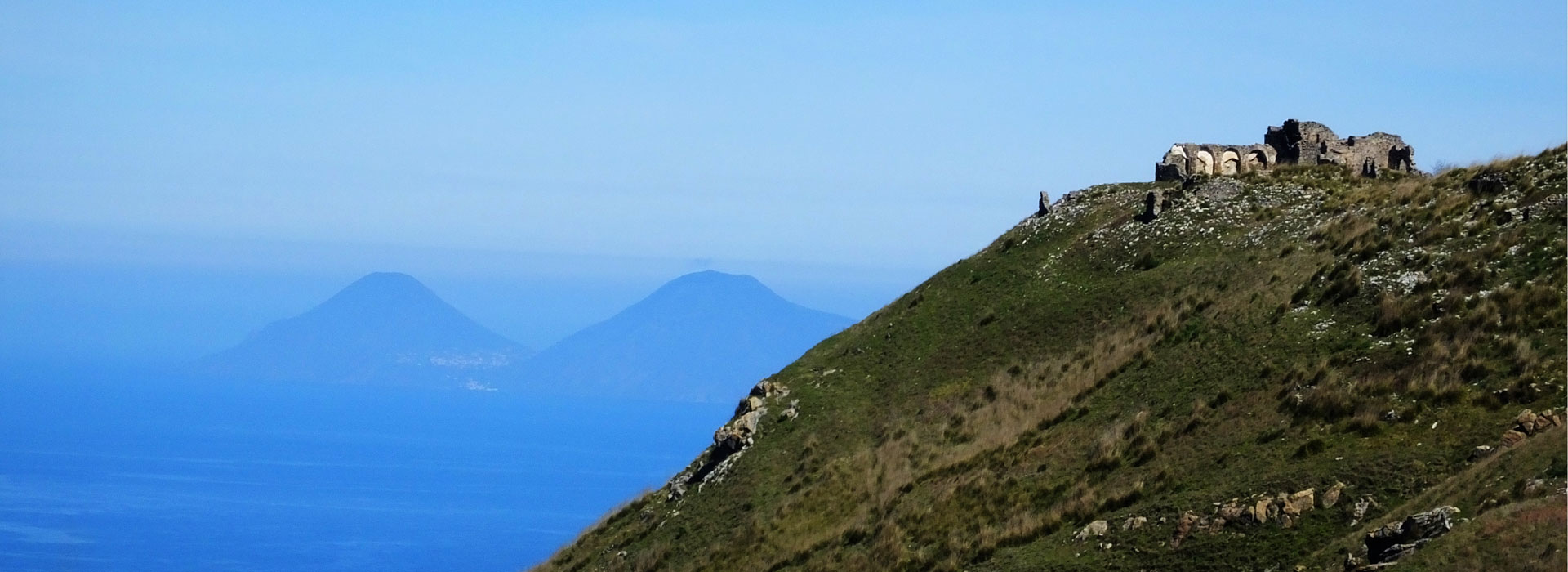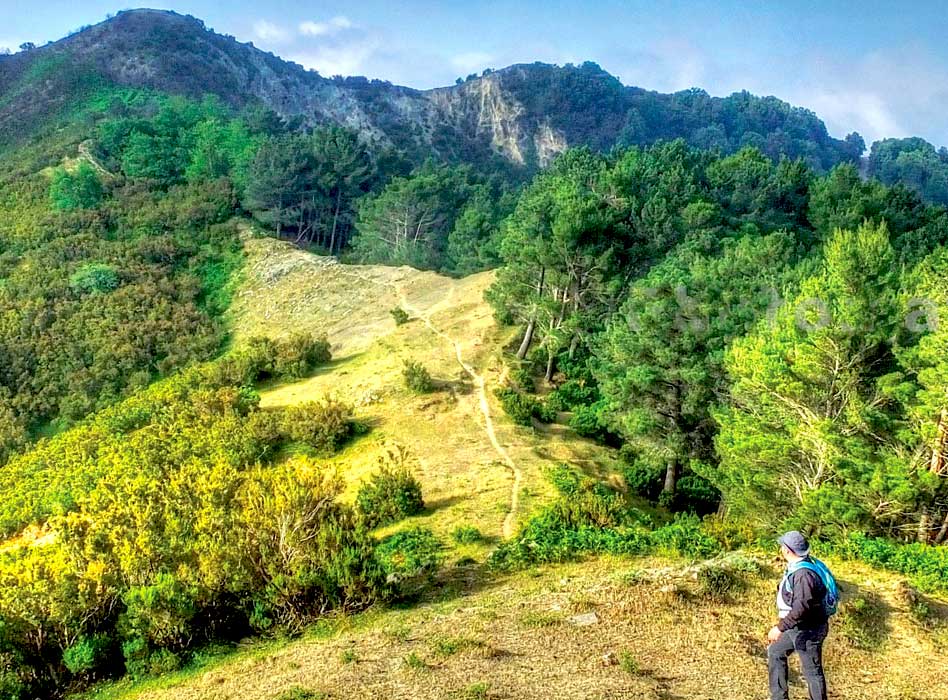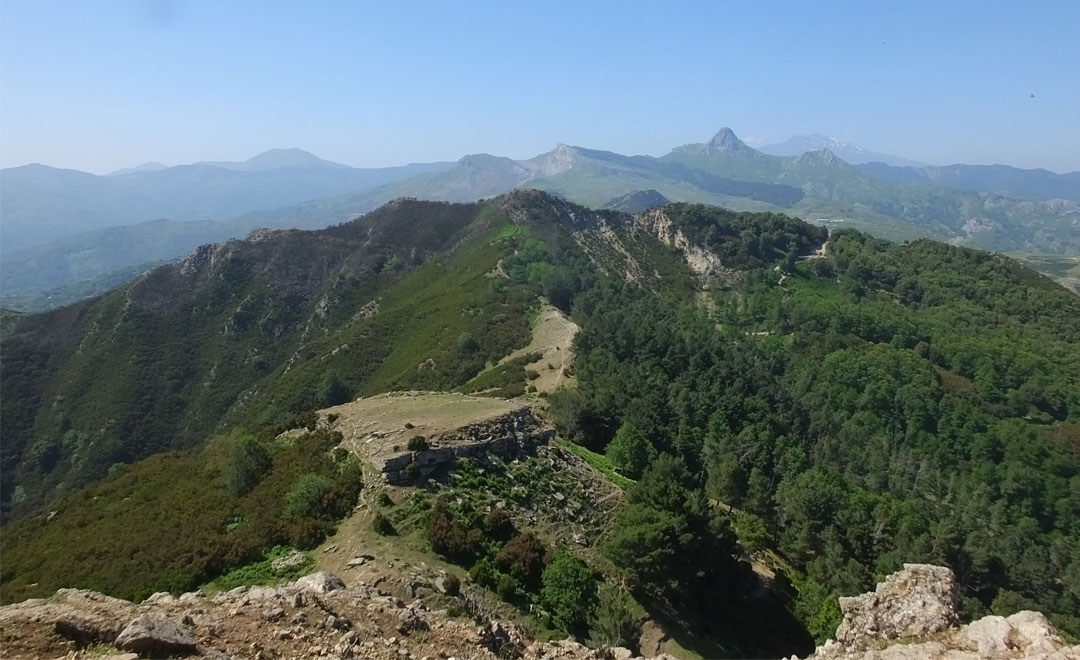An imposing mountain range with a lonely and fascinating landscape: we are in the northeastern extremity of Sicily where the Peloritan ridge, before meeting the Nebrodi near Rocca Novara and Montagna Grande, rises as a natural continuation of the Calabrian Apennines, with which it shares the geological composition as well as the characteristic fiumare, short streams impetuous in winter and dry in summer, with a wide, pebbly bed.
According to legend, the Peloritani are named after Pelorus, who was helmsman of the ship of the famous Carthaginian leader Hannibal. When the African general was driven into the Strait of Messina he believed he was in a landlocked gulf, since the Sicilian and Calabrian coasts were so close that they seemed to his eyes to be a single strip of land. Believing, therefore, that he had been deceived, he decided to have Pelorus killed, but realizing his mistake almost immediately, he undertook to have a huge statue erected in his memory on the northeastern tip of Sicily, which has been called Cape Pelorus ever since. The myth is recounted by several authors, including Valerius Maximus, who writes “from a height of that stormy strait a statue is offered to the eyes of those who cross it in both directions, placed as a testimony and reminder as much of Pelorus as of Punic temerity.” However, as early as the sixth century BC. B.C., three hundred years earlier, the cult of the nymph Pelorias was practiced, who is said to have inhabited the marshes in the area, and who was depicted on coins of the time.
More realistically, Peloritano would derive from a Greek term with the meaning of “boundless, gigantic,” as these mountains must have appeared upon the arrival of the Greeks in Sicily in the 8th century BC.

And along this ridge rich in legends is one of the most exciting mountain bike routes in Sicily, Provincial Road 50 bis, an unusual and fascinating 70-kilometer route that runs between Portella San Rizzo and Portella Mandrazzi, passing through unspoiled and majestic nature, breathtaking landscapes that open now on the Tyrrhenian side now on the Ionian side, and historical-religious testimonies that hark back to ancient times.
In fact, the route has great historical significance, being in the vicinity of Mount Scuderi, where the ruins of the ancient Byzantine city of Mikos stand. Moreover, the current sp 50 bis, since Roman times was a military road, a very important connecting route that linked the two passes of Portella San Rizzo and Mandrazzi. Even in medieval times and later periods it was traveled not only for military purposes, but also for commercial and strategic purposes, representing the shortest natural route for the inhabitants of the inland municipalities to travel to the coastal areas. During the Kingdom of Italy, access was then authorized only to the military to reach the defensive outposts of the Strait of Messina and the Plain of Milazzo: the Umbertini Forts and the Batterie.
The route, which runs mostly on dirt and in some stretches on screed, is challenging and requires MTB experience, but the effort will be rewarded by the extraordinary beauty of a landscape full of forests, canyons, gorges carved out by watercourses, small waterfalls and, certainly not least, places to indulge in pleasant gourmet stops.
In this regard, near the departure from Portella San Rizzo, we immediately find “Don Minico,” the historic eatery born of Don Minico’s intuition in the 1950s, now run by his children and grandchildren who have expanded the business by creating a farm and wine business. The specialty is the famous “panino alla disgraziata,” a wheel of wheat-flour bread stuffed with strictly local products: vegetables in oil, semi-seasoned cheese produced in the Peloritani and medium-grain local salami. One sits outside on the wooden benches, savoring the succulent sandwich while contemplating wonderful glimpses of the sea among the surrounding vegetation. Refreshment for the body and the mind.
The setting of Don Minico’s “House of Cure,” as the son has renamed his father’s creation, is original and welcoming and worth a visit in itself, with the posters and slogans extolling the magical virtues of the wretched sandwich, not a simple piece of stuffed bread, but a food with “saving” power, able to cure any ailment with its goodness. Today, patrons’ opinions are divided between longtime fans, who consider the sandwich not up to the standard of what it once was, and, on the other hand, current admirers, who are certain that the quality and taste are still the same as they once were. Whichever way you look at it, Don Minico is and remains an institution as well as being, logistically speaking, ideally located to stock up on food in anticipation of the long leg ahead.
The route from Portella San Rizzo starts immediately with a challenging climb in the midst of a very green forest of pines, chestnut trees, holm oaks and downy oaks that reaches the Sanctuary of the Madonna of Dinnammare, located at 1,130m above sea level, whose name is said to derive from the Latin word “bimaris,” indicating precisely the spectacular view from this place over the two seas, Tyrrhenian and Ionian. We are in fact at the highest part of Cape Peloro, in a magnificent position overlooking the Aeolian Islands, the Bay of Milazzo, Tindari, the Strait and Scilla. The Sanctuary, often shrouded in a haze that adds to its aura of mystery, stands on top of the mountain of the same name and is an extraordinary crossroads that attracts a melting pot of visitors: not only cyclists engaged in the route of the Peloritanian ridge who after the arduous climb take a breath here breathing in the immensity of its panoramas, but also groups of bikers riding their motorcycles, faithful pilgrims, hikers who penetrate the paths within the Peloritani, birdwatchers intent on observing the migration of birds of prey over the Strait in spring and autumn and finally simple excursionists hunting for views to immortalize with a photographic shot. An evocative and emblematic place that combines spirituality with an exceptional natural and scenic setting.

After the sanctuary, the itinerary proceeds for 40 km between climbs and descents that reveal striking views of Etna, the Aeolian Islands and, between Pizzo Bottino and Pizzo Cavallo, coastal stretches. We pass by the Casa degli Alpini refuge (859 m a.s.l.), nestled in the beautiful Fiumedinisi Reserve, the only protected area crossed by the ridge. Here the landscape is characterized by beautiful specimens of chestnut trees, sycamore maples, hollies and laurels and the Fiumara di Fiumedinisi. Not far from the refuge, next to a spring, is a superb view of Etna’s northern slope. We continue along the Santissima, a 7-kilometer descent that just before ending in the village of Fiumedinisi boasts an excellent family-run refreshment point in a splendid stretch of unspoiled wilderness: “Rusti e Mancia Cannetti.” Set in a deep, narrow green valley, the farmhouse, located on the side of the road, with its spartan wooden structure reminiscent of a mountain cabin blends perfectly into its surroundings. Accompanying the greedy lunch is the lapping of small freshwater waterfalls that form pools on the bed of the Nisi River, just below the agriturismo. Everything here is homemade: from the pasta made by the skillful hands of Mrs. Carmela, in the two variations “alla norma,” with tomato, chunks of fried eggplant and a generous sprinkling of ricotta cheese, and “con il sugo di maiale” (the latter deserves special mention), to the meat – sausage, Messina chops and veal stew – cooked by her husband Giovanni. Welcoming patrons is the kindness of Santina, who with her brother helps run the restaurant. The formula is that of a set menu: as a prelude to the “strong” dishes described above, a good mixed appetizer is served that encompasses the specialties of the area, from cheeses and cured meats to sun-dried tomatoes and olives, along with delicious meatballs, vegetables and ricotta cheese in batter, while delicious ricotta cheese fritters close the meal. In the summer season, baked mutton, made with a long cooking time of at least six hours according to the dictates of ancient Messina tradition, is tasted. By reservation, the restaurant is open for both lunch and dinner, with flexible hours based on requests received.
Refreshed, we continue to the third highest peak in the Peloritani Mountains, Pizzo di Vernà (1,287m a.s.l.), with a landscape of untouched vegetation: arboreal heather plants, farnie and poplars along the streams. From the summit of Vernà springs, moreover, the Mela stream, which is an important site for the presence of Woodwardiaradicans, a very rare fern.
The route draws to a close at Portella Mandrazzi crossing one of the most picturesque areas of the trail, whose lush forests along with panoramic views will remain an indelible memory of this magical route.

